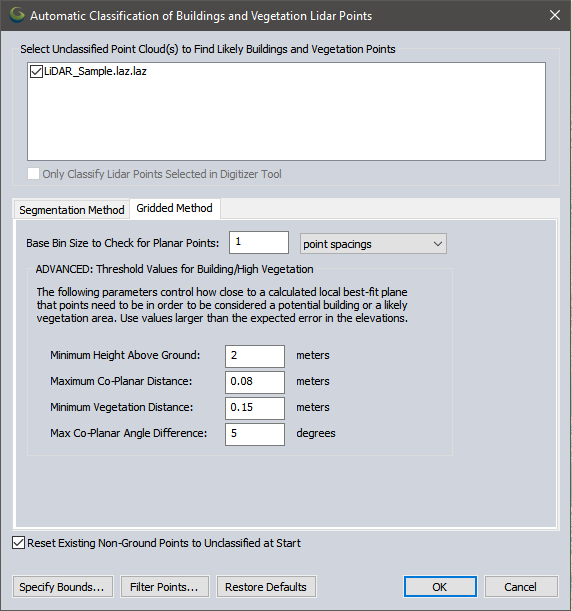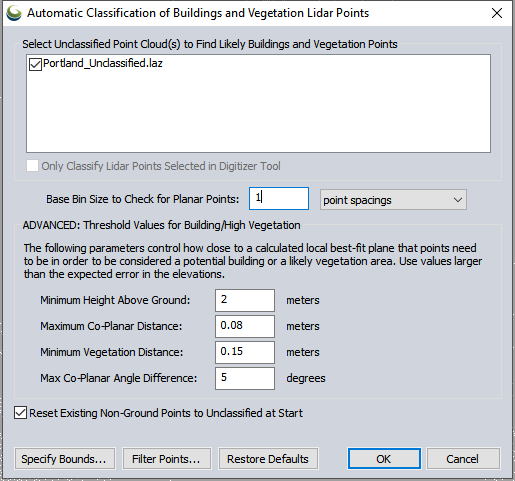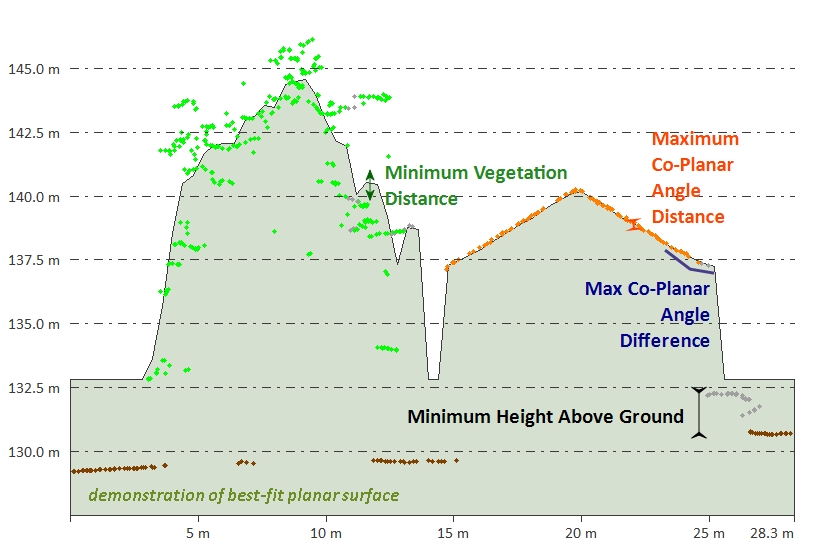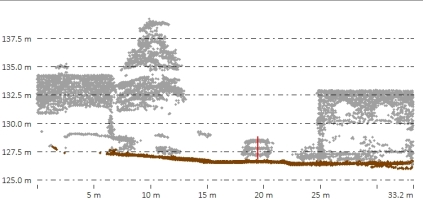 Auto-Classify Buildings and Vegetation Points: Gridded Method
Auto-Classify Buildings and Vegetation Points: Gridded Method
The Auto-Classify Buildings and Vegetation Points tool allows the user to automatically classify Buildings and Vegetation. The Gridded Method is best designed for use with aerial lidar, and has been superseded by Auto-Classify Non-Ground Lidar Points.
To access this tool press the  Auto-Classify Non-Ground Lidar Points from the Lidar Automatic Classification toolbar. Set Gridded Method tab as the active tab.
Auto-Classify Non-Ground Lidar Points from the Lidar Automatic Classification toolbar. Set Gridded Method tab as the active tab.
This tool can also be accessed from the favorites dropdown. Select Setup Favorites List then in the Favorites List Setup dialog check the option Auto-Classify Buildings and Vegetation Points. Once added choose this option from the favorites dropdown, and then press  Run Selected Command button to use this tool.
Run Selected Command button to use this tool.
![]() This tool requires Global Mapper Pro.
This tool requires Global Mapper Pro.
Clicking this option brings up the Automatic Classification of Buildings and Vegetation Lidar Points settings window (below).


Select Unclassified Point Cloud(s) to find Likely Non-Ground Points
Use the check-boxes in this section if more than one Lidar data set is loaded into workspace, specific Lidar layers may be selected (check in box), or unselected (box empty), for automated classification.
Check the option to 'Only Classify Lidar Points Selected in Digitizer Tool' to run classification tool only on points selected by the Digitizer tool.
Building/ High Vegetation Classification Setup
The setup options found under Building/High Vegetation Classification and Powerline Classification Setup can be used to adjust the classification parameters to ground conditions and the density and quality of the lidar points.
Check the Find and Classify Likely Building and Vegetation points to enable this algorithm, and allow modification of the below parameters.
The building and tree classification algorithm classifies points as "building" or "tree" based on their relationship to a calculated best-fit planar surface inside each segment (bin) of lidar data. Points that are close to the calculated plane are classified as building, and point that are far from the planar surface are classified as high vegetation.
Base Bin Size to Check for Planar Points
This setting specifies the size of each bin using either Point Spacings or Meters when evaluating points to see how far they are from a calculated planar surface.
For example, using Point Spacings a value of "3.0" would make each square bin 3 times the calculated native spacing of the point data. To specify a spacing in meters rather than as a multiple of the native spacing for the point cloud, select 'Meters' from the drop down menu.
For building and tree classification, a starting point is to use the equivalent of 3 point spacings as a base bin size.
Advanced Settings
The settings below specify the exact parameters for comparing points to the best-fit planar surface, to classify building and tree points.

Minimum Height Above Ground
Use this setting to specify the minimum height above ground that a point has to be in order to consider it as a possible building or high vegetation point.
The default value is 2 meters. Typically, buildings and high vegetation points are at least 2 to 2.5 meters above the ground, as in the example below. This value can help eliminate other objects, such as cars, from the classification.
The red line in the above path profile views illustrates the 2 meter height above ground, in comparison to a car. All points below the height above ground value will be removed from consideration as buildings or trees.
Maximum Co-Planar Distance
Use
this field to set the maximum co-planar distance in meters to use for classifying
non-ground points. This specifies the maximum RMSE (root mean square error) from a best-fit local plane that the points in a small region all have to be within, in order to consider the region a building. It is a tolerance or error value relative to a planar surface that would represent a building.
Minimum Vegetation Distance
Use this field to set the maximum distance (in meters) that the points in a small region all have to be within, in order to consider the region a potential vegetative region. Used for auto-classifying non-ground, vegetation points.
This value must be larger than the maximum co-planar distance.
Max Co-Planar Angle Difference
Use this field to set the maximum angle difference (in degrees) to be used when auto-classifying non-ground points. Specifically, this will determine the maximum angle (in degrees) between adjacent best-fit planes, such that they can still be considered part of the same plane when identifying flat building surfaces.
Reset Existing Non-Ground Points to Unclassified at Start
Resets the Unclassified Non-Ground Point data, resetting any points classified as non-ground. Removes all manual and automatic classification of ground points in selected point data, setting all points to unclassified.
Specify Bounds
Use Specify Bounds... to set the bounds for the classification by drawing a box on the workspace, by using coordinate extents, or by cropping to a selected area feature.
When classifying a large dataset, it is recommended to test the classification on a sample area. Run the classifications multiple times on the sample area, adjusting to values, to obtain a good classification result prior to processing the entire data extent.
Filter Points
Filter Points...Contains additional
settings for filtering points for classification by elevation and color
values, Source ID, and existing classification. The user may also exclude
all points outside of a specified scan angle.
